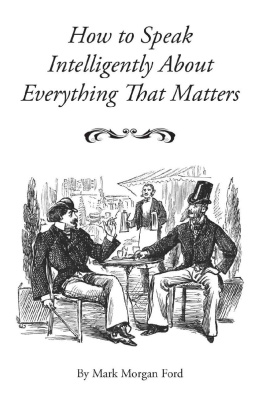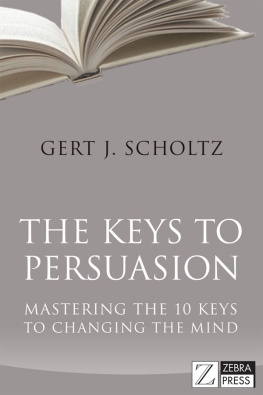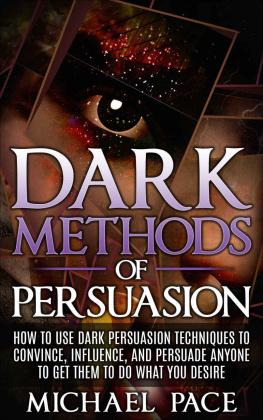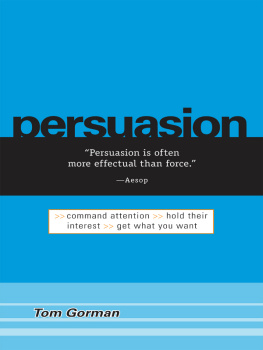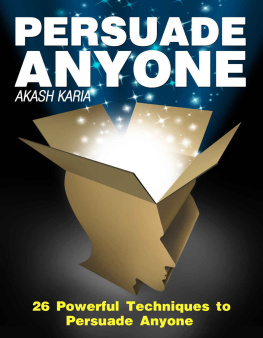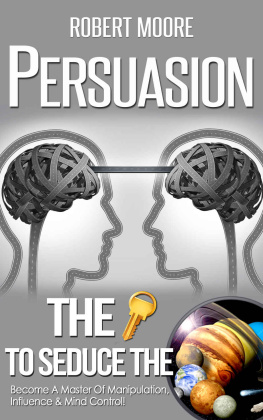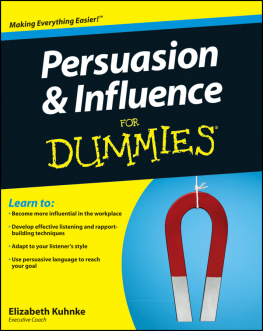The Subtle Art of Getting What You Want
Mark Morgan Ford
and Will Newman

American Writers & Artists Inc.
245 NE 4th Avenue, Suite 102
Delray Beach, FL 33483
Phone: 561-278-5557
Fax: 561-278-5929
Website: www.awaionline.com
Mark Morgan Ford, 2014. All rights reserved.
Protected by copyright laws of the United States and international treaties.
No part of this publication in whole or in part may be copied, duplicated, reproduced or transmitted in any form or by any means, electronic or mechanical, including photocopying, recording, or by any information storage and retrieval system, without the express written permission from the publisher.
Copyright and other intellectual property laws protect these materials and any unauthorized reproduction or retransmission will constitute an infringement of copyright law.
Federal law provides severe civil and criminal penalties for the unauthorized reproduction, distribution, or exhibition of copyrighted materials. Penalties for criminal and statutory copyright infringement are set forth at 18 U.S.C. 2319.
ISBN-13: 978-0-9821500-4-7
ISBN-10: 0-9821500-4-0
Mastering the skill of persuasion will make all your ambitions more achievable. It will make you feel smarter and shrewder and more confident in almost every situation.
Mark Morgan Ford

Introduction
Persuasion Matters
E ver since Eve sweet-talked Adam into biting into that mythic, mouth-watering apple, men (and women) have lived in a world where persuasion matters.
Persuasion played a role in the building of the Egyptian pyramids, the creation of democracy in Athens, the development of common law in England, the unification of Italy, the outbreak of World War I, the development of the atomic bomb, the United Nations, space exploration, satellite technology, and the Internet.
And so long as we engage in enterprise, education, exploration, politics, and charity, persuasion will continue to matter. It will matter when it comes to building cities, winning votes, spreading religion, starting wars, ending wars, winning love, and promoting hate.
The effects of persuasion are everywhere. In the products we buy, the books we read, the movies we watch, the cities we visit, the teams we root for, the celebrities we admire, the candidates we vote for, the foods we eat and the people we sleep with.
Persuasion matters. It affects usdirectly and indirectly, publicly and personallywhether we want it to or not.
It is foolish to ignore it. Wise to understand it.
And we have been trying to understand persuasion for as long as weve been trying to understand anything. Since the age of Aristotle at least, countless treatises, essays, monographs, books, and verbal arguments have explored, analyzed, dissected, and argued about what persuasion is and how it works.
Many of those arguments are still (ahem) persuasive today.
This book will not add to that body of literature in depth or breadth, but it has a purpose: to reduce some of what I believe are the truest things that have been said about persuasion to a single formula that is simple and easy to use.
A Long Time Coming
I have been thinking about the art of persuasion since I entered the direct response publishing industry more than thirty-five years ago.
During the first twenty years of my career I read everything I could about persuasive writing. I also taught what I had read to anyone that would listen. Back then, my ideas were elaborate and unlimited. They had more to do with quantity than quality.
Some of the ideas I taught worked for writing sales letters but not for business memos. Others made sense in one situation but not in another. Some overlapped. Others contradicted each other. The more I learned the more confused I got. I can only imagine the confusion of my students.
At the start of my editing career, I thought communications highest purpose was the expression of truth. Back then, I thought truth was absolute and undeniable. Working as a writer and editor for a wide range of publicationsfrom Robotics Update to Professional Practice Management to Penny Stock Profits wised me up.
I began to see that in almost every non-violent environmentpersonal, commercial, political, socialpower went to those that had the better argument.
I read essays on rhetoric, studied books on effective writing, took courses in speech makingalways looking for the essential components of persuasion. By the time I became a consultant to Agora in the mid 1990s, I had accumulated hundreds of rules about persuasive writing. They were useful when critiquing and/or editing particular essays and sales letters. But they were less effective in teaching young writers.
However, two ideas were resilient. They seemed to apply to every persuasive challenge.
1. The emotionally compelling idea
This insight was inspired by Aristotle, who noted that the beating heart of a work of fiction is the plot. For me, the equivalent in nonfiction writingits beating heartwas the emotionally compelling idea.
2. The Rule of One
I developed the Rule of One after critiquing a great deal of bad writing. I could see that my own best essays were those that kept to a single, useful thought. My bad essays had many thoughts in them, most of them wrong or mediocre. I saw this in the writing of my protgs, both novices and experienced writers. When they had nothing really compelling to say, they said lots of ordinary things. It was as if they were trying to compensate for the lack of quality by quantity.
In practice, these two concepts are related, because the Rule of One is about the emotionally compelling idea. So that became the basis of my first stab at a unified formula for persuasive writing.
I introduced my formula to forty professional writers at a seminar in France in 2008. Some of them were journalists, some essayists, and some advertising copywriters. I then revised and simplified it by teaching it to dozens of my clientsmarketers, copywriters, speechwriters, business owners, fundraisers, executives, and teachers.
In 2012, I asked Will Newmanwho had been a mentor for young copywriters at American Writers & Artists Inc. (AWAI) for more than a decadeto help me turn the formula into a book about the art of persuasion in general, not just as it applies to writing.
This book is the result of that collaboration.
This is not a self-help book, but it should be helpful. It will help you accomplish pretty much everything you want.
Its not a get-rich book either, but it can certainly help you make money. Making money is perhaps the easiest of all things you can do with a mastery of persuasion.
And its not a book about personal power, but it can make you very powerful since you will be able to influence the way people think about thingsincluding how they think about you.
Mastering the skill of persuasion will make all your ambitions more achievable. It will make you feel smarter and shrewder and more confident in almost every situation. You wont have all the answers, but you will have a good idea about how to get people to embrace the answers you believe in.
Although most of the examples in this book are from written material, the principles apply to oral communication as well. It doesnt matter whether you are having a conversation at breakfast with a group of friends, responding to an email from your boss, chatting with a colleague on a break, writing a memo, talking to your banker about a loan, making a speech to get your candidate elected, drafting a letter to raise money for a favorite cause what you learn in these pages will give you the power to succeed.


